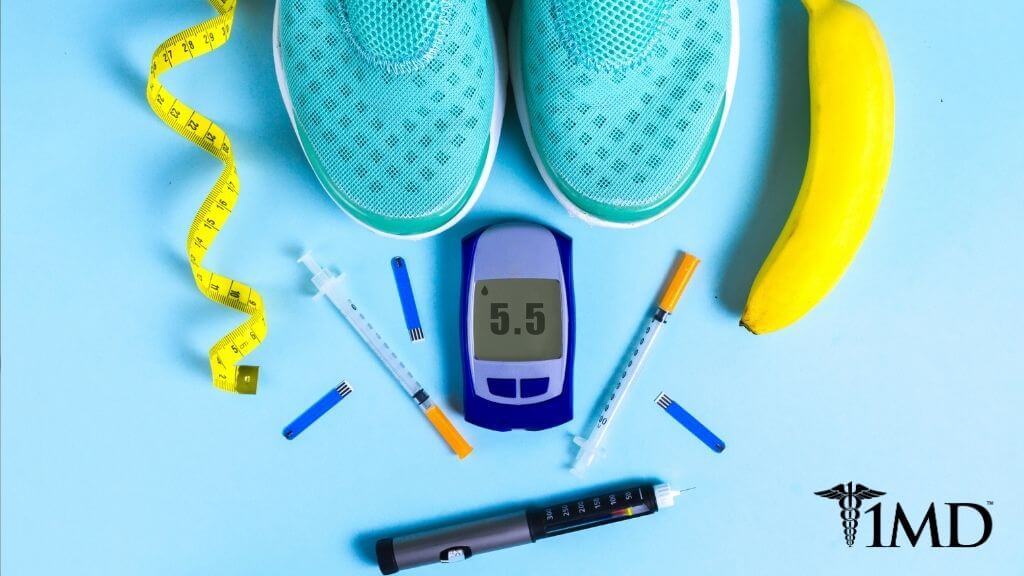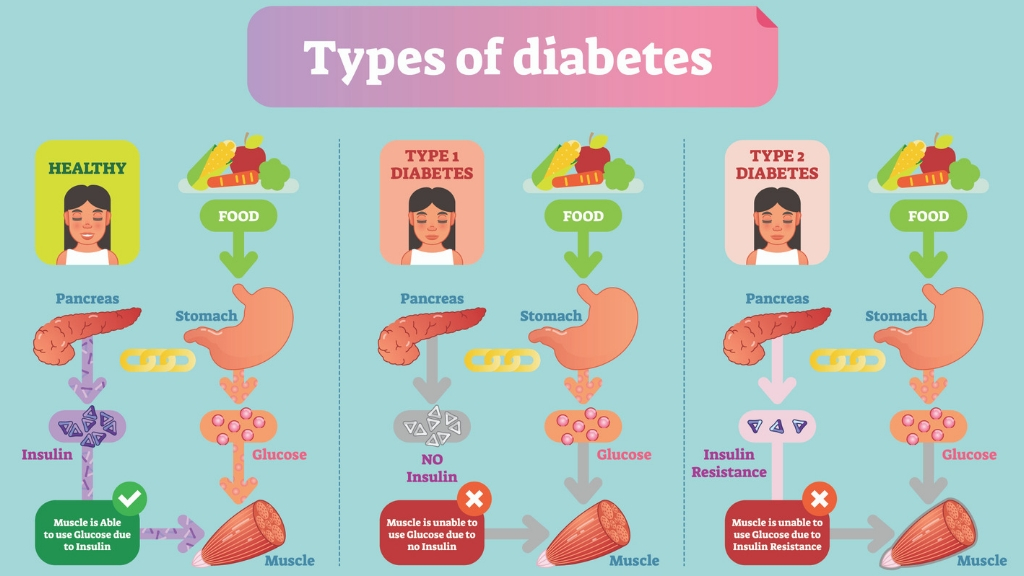What Is Diabetes? A Quick Guide to Types, Causes, Symptoms, & Help
10 minute read
More than 100 million U.S. adults are now living with diabetes or prediabetes, according to a new report released by the Centers for Disease Control and Prevention (CDC). The report finds that as of 2015, 30.3 million Americans, or 9.4 percent of the U.S. population, have diabetes.
Another 84.1 million have prediabetes, a condition that if not treated often leads to type 2 diabetes within five years.
People with diabetes are living longer, healthier lives with fewer complications. What’s the driving force? Greater awareness and better control of risk factors are moving the needle.
What Is Diabetes?
There are four main types of diabetes:
Type 1 diabetes: Your body does not make insulin. This is a problem because you need insulin to take the sugar (glucose) from the foods you eat and turn it into energy for your body. You need to take insulin every day to live.
Type 2 diabetes: Your body does not make or use insulin well. You may need to take pills or insulin to help control your diabetes. Type 2 is the most common type of diabetes.
Gestational (jest-TAY-shun-al) diabetes: Some women get this kind of diabetes when they are pregnant. Most of the time, it goes away after the baby is born. But even if it goes away, these women and their children have a greater chance of getting diabetes later in life.
Prediabetes: In the US, 84.1 million adults—more than 1 in 3—have prediabetes, and 90% of them don’t know they have it. Prediabetes is a serious health condition where blood sugar levels are higher than normal, but not high enough yet to be diagnosed as diabetes.

Prediabetes increases your risk for type 2 diabetes, heart disease, and stroke.
Diabetes Symptoms
The following symptoms of diabetes are typical. However, some people with type 2 diabetes have symptoms so mild that they go unnoticed.
Common symptoms of diabetes:
♦ Urinating often
♦ Feeling very thirsty
♦ Feeling very hungry even though you are eating
♦ Extreme fatigue
♦ Blurry vision
♦ Cuts/bruises that are slow to heal
♦ Weight loss even though you are eating more (type 1)
♦ Tingling, pain, or numbness in the hands/feet (type 2)
Although there are many similarities between type 1 and type 2 diabetes, the cause of each is very different. And the treatment is usually quite different, too.
Some people, especially adults who are newly diagnosed with type 1 diabetes, may have symptoms similar to type 2 diabetes and this overlap between types can be confusing.
The ABCs of Diabetes
A1C: The A1C test gives your doctor important insight into your blood glucose levels over the previous two to three months. It's a good idea to check your A1C level twice a year.
For most people who have diabetes, the goal is an A1C of less than 7 percent. Your physician will advise you on your target A1C.
Blood pressure: Studies have found that at least 1 in 3 patients with type 1 diabetes also have high blood pressure or hypertension. When hypertension and diabetes coexist, the effects of one disease tend to make the other worse. This makes for a deadly combination.
Patients should report any consistent blood pressure readings of 140/90 or higher to their doctors, as these may result in complications. Hypertension won’t go away without treatment, which could include lifestyle changes and, if your doctor prescribes it, medication.

Cholesterol: In people with diabetes, LDL, or "bad" cholesterol, tends to build up and clog the arteries. Triglycerides, another form of fat that can cause atherosclerosis, also tend to be abnormally high in diabetes.
HDL, or "good" cholesterol, helps keep the arteries healthy by removing cholesterol from the body. In diabetes, HDL levels tend to be lower than normal. This combination of abnormal lipid levels is often seen in people with premature heart disease.
Coping With a Diabetes Diagnosis
Eating Well
When you have diabetes, deciding what, when, and how much to eat may seem challenging. So, what can you eat, and how can you fit the foods you love into your meal plan? Eating healthy food at home and choosing healthy food when eating out are important in managing your diabetes.
The first step is to work with your doctor or dietitian to make a meal plan just for you. As soon as you find out you have diabetes, ask for a meeting with your doctor or dietitian to discuss how to make and follow a meal plan.
Curcumin, the active component found in turmeric, has been used to treat conditions like rheumatism, fatigue, and diabetes in traditional Ayurvedic medicine for thousands of years. A study found that nano-formulation of curcumin significantly lowered blood sugar levels in diabetic patients.
There are also several older studies that show how curcumin lowers blood sugar in mice and rats. Learn more about the benefits of curcumin for adults with diabetes.
Getting Active
If you have diabetes, being active makes your body more sensitive to insulin (the hormone that allows cells in your body to use blood sugar for energy), which helps manage your diabetes. Physical activity also helps control blood sugar levels and lowers your risk of heart disease and nerve damage.
Set a goal to be more active most days of the week. Start slow by taking 10-minute walks, 3 times a day. Twice a week, work to increase your muscle strength. Use stretch bands, do yoga, heavy gardening (digging and planting with tools), or try push-ups.

Stay at or get to a healthy weight by using your meal plan and moving more.
Never Stop Learning
Diabetes treatment is evolving all the time. Keeping up to date with the latest information will help you make better choices, prevent complications, and get early treatment if complications do arise.
Your diabetes management may change as your body changes over time. Treatment for diabetes may also need adjusting. Follow these tips:
♦ Stay current
♦ Attend a diabetes class
♦ Research treatment developments via the Internet
♦ Talk to your health care team
♦ Ask them for a recommendation
You’re Not Alone
Friends and family care and want to help, but they often don’t know how. Maybe they can make the appointment, or join in at the appointment, or pick up medications.
Let them know specifically how to help and don’t be afraid to ask for assistance. Communication is key.
Get Involved
Diabetes advocacy improves healthcare and bolsters research to find a cure. Being a part of this endeavor not only helps to achieve these goals, it makes you feel good about yourself. And when you feel better about yourself, you are more motivated to take better care of yourself.
Diabetes is a serious disease that can often be managed through physical activity, diet, and the appropriate use of insulin and other medications to control blood sugar levels. People with diabetes are at increased risk of serious health complications including premature death, vision loss, heart disease, stroke, kidney failure, and amputation of toes, feet, or legs.
You Are in Charge
You’re in the driver’s seat when it comes to managing your diabetes—watching what you eat, making time for physical activity, taking meds, checking your blood sugar. Also be sure to stay in touch with your health care team to keep going in the right direction.

Everyone’s diabetes is different. Some people will still have complications even with good control. Maybe that’s you—you’ve been trying hard but not seeing results. Or you’ve developed a health problem related to diabetes in spite of your best efforts.
The Bottom Line
If you feel discouraged and frustrated, you may slip into unhealthy habits, stop monitoring your blood sugar, even skip doctors’ appointments. That’s when your team can help you get back on track, from setting goals and reminding you of your progress to offering new ideas and strategies. Diabetes is very common; even Tom Hanks has had to deal with it.
Looking for more resources? Head over to Beyond Type 1's website for in-depth information on a whole host of topics related to diagnosing, treating, and living with diabetes. Then, join them as an advocate to increase funding to prevent, treat and cure diabetes; improve access to health care; and eliminate discrimination against people with diabetes at school, work, and elsewhere in their lives.












